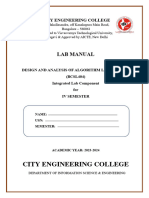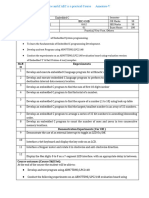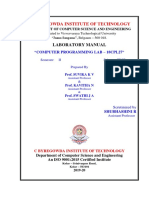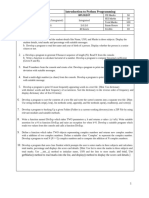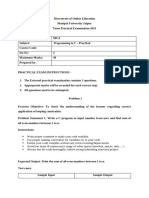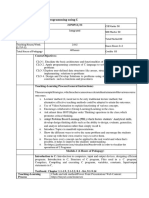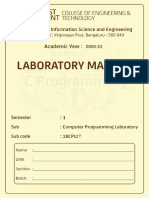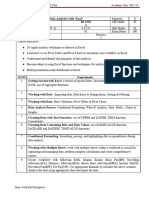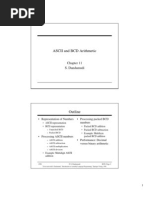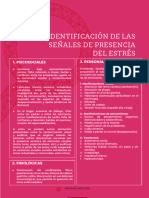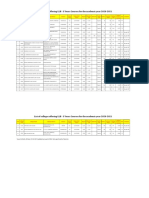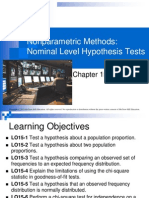0 ratings0% found this document useful (0 votes)
84 viewsCPL (LAB) SYLLABUS (Sem 1)
CPL (LAB) SYLLABUS (Sem 1)
Uploaded by
Rock OPThe document describes a computer programming laboratory course. The course objectives include explaining problem statements, demonstrating programming skills in C, and developing algorithms and programs to solve problems. Students complete programming assignments that involve calculations, searching, sorting, strings, structures, pointers, and recursion. Assessment includes continuous internal evaluation of programming assignments and a semester exam consisting of programming short answer and demonstration questions.
Copyright:
© All Rights Reserved
Available Formats
Download as PDF, TXT or read online from Scribd
CPL (LAB) SYLLABUS (Sem 1)
CPL (LAB) SYLLABUS (Sem 1)
Uploaded by
Rock OP0 ratings0% found this document useful (0 votes)
84 views2 pagesThe document describes a computer programming laboratory course. The course objectives include explaining problem statements, demonstrating programming skills in C, and developing algorithms and programs to solve problems. Students complete programming assignments that involve calculations, searching, sorting, strings, structures, pointers, and recursion. Assessment includes continuous internal evaluation of programming assignments and a semester exam consisting of programming short answer and demonstration questions.
Original Title
CPL[LAB] SYLLABUS (Sem 1)
Copyright
© © All Rights Reserved
Available Formats
PDF, TXT or read online from Scribd
Share this document
Did you find this document useful?
Is this content inappropriate?
The document describes a computer programming laboratory course. The course objectives include explaining problem statements, demonstrating programming skills in C, and developing algorithms and programs to solve problems. Students complete programming assignments that involve calculations, searching, sorting, strings, structures, pointers, and recursion. Assessment includes continuous internal evaluation of programming assignments and a semester exam consisting of programming short answer and demonstration questions.
Copyright:
© All Rights Reserved
Available Formats
Download as PDF, TXT or read online from Scribd
Download as pdf or txt
0 ratings0% found this document useful (0 votes)
84 views2 pagesCPL (LAB) SYLLABUS (Sem 1)
CPL (LAB) SYLLABUS (Sem 1)
Uploaded by
Rock OPThe document describes a computer programming laboratory course. The course objectives include explaining problem statements, demonstrating programming skills in C, and developing algorithms and programs to solve problems. Students complete programming assignments that involve calculations, searching, sorting, strings, structures, pointers, and recursion. Assessment includes continuous internal evaluation of programming assignments and a semester exam consisting of programming short answer and demonstration questions.
Copyright:
© All Rights Reserved
Available Formats
Download as PDF, TXT or read online from Scribd
Download as pdf or txt
You are on page 1of 2
COMPUTER PROGRAMMING LABORATORY
Course Code 21CPL27/17 CIE Marks 50
Teaching Hours/Week (L: T:P: S) 0:0:2:0 SEE Marks 50
Total Hours of Pedagogy -- Total Marks 100
Credits 01 Exam Hours 03
Course Objectives:
1. Explain problem statements and identify appropriate solutions
2. Demonstrate the use of IDE, C Compiler, and identify and rectify the syntax and
syntactic errors during programming.
3. Development of algorithms and programs using constructs of C programming language
4. Reporting the observations
Sl. No. Practise Programs
1 Calculation of Simple Interest,
2 Check whether the given number is even or odd
3 Convert string case
4 Check for the palindrome, prime number, perfect square.
5 Development of linear search algorithm Etc…
PART A-List of problems for which students should develop the program and execute in
the Laboratory
1 Simulation of a Simple Calculator.
2 Compute the roots of a quadratic equation by accepting the coefficients. Print
appropriate messages.
3 An electricity board charges the following rates for the use of electricity: for the
first 200 units 80 paise per unit: for the next 100 units 90 paise per unit: beyond
300 units Rs 1 per unit. All users are charged a minimum of Rs. 100 as meter
charge. If the total amount is more than Rs 400, then an additional surcharge of
15% of the total amount is charged. Write a program to read the name of the user,
the number of units consumed, and print out the charges.
5 Implement Binary Search on Integers / Names.
6 Implement Matrix multiplication and validate the rules of multiplication.
7 Compute sin(x)/cos(x) using Taylor series approximation. Compare your result
with the built-in library function. Print both the results with appropriate
inferences.
8 Sort the given set of N numbers using Bubble sort.
9 Write functions to implement string operations such as compare, concatenate,
string length. Convince the parameter passing techniques.
10 Implement structures to read, write and compute average- marks and the students
scoring above and below the average marks for a class of N students.
11 Develop a program using pointers to compute the sum, mean and standard
deviation of all elements stored in an array of N real numbers.
12 Implement Recursive functions for Binary to Decimal Conversion.
PART B – Practical Based Learning
A problem statement for each batch is to be generated in consultation with
the co-examiner and the student should develop an algorithm, program and
execute the program for the given problem with appropriate outputs.
Course Outcome (Course Skill Set)
At the end of the course the student will be able to:
1. Define the problem statement and identify the need for computer programming
2. Make use of C compiler, IDE for programming, identify and correct the syntax and
syntactic errors in programming
3. Develop algorithm, flowchart and write programs to solve the given problem
4. Demonstrate use of functions, recursive functions, arrays, strings, structures and
pointers in problem solving.
5. Document the inference and observations made from the implementation.
Assessment Details (both CIE and SEE)
The weightage of Continuous Internal Evaluation (CIE) is 50% and for Semester End Exam
(SEE) is 50%. The minimum passing mark for the CIE is 50% of the maximum marks (25
marks). A student shall be deemed to have satisfied the academic requirements and earned the
credits allotted to each course. The student has to secure not less than 35% (18 Marks out of
50) in the semester-end examination(SEE).
Continuous Internal Evaluation (CIE):
75% CIE marks awarded in case of practical shall be based on the weekly evaluation of
laboratory journals/ reports after the conduction of every experiment and 25% marks for one
practice test for practical-based learning.
Semester End Evaluation (SEE):
1. The practical examinations are to be conducted as per the timetable of the University in
batch-wise with the strength of students not more than 10-15 per batch.
2. All laboratory experiments (Part A) are to be included for practical examination.
3. Students can pick one experiment from the questions lot of PART A with the equal
choice to all the students in a batch.
For PART B examiners should frame a question for each batch, the student should
develop an algorithm, program, execute and demonstrate the results with
appropriate output for the given problem.
4. Weightage of marks for PART A is 80% and for PART B is 20%
5. Change of experiment is allowed only once for part A and 15% Marks allotted to the
procedure part to be made zero. However, PART B question is mandatory (change of
question is not allowed).
6. Marks distribution: procedure (15%) + execution (70%) + viva voce (15%)
PART A (12+56+12 = 80) AND FOR PART B (3+14+3 = 20)
Suggested Learning Resources:
1. Yashavanth Kanetkar, Let us C, Authentic Guide to C Programming Langauge, bpb
publisher, 17th Edition, 2020.
2. Herbert Schildt, C: The complete reference, Mc Graw Hill, 4th Edition, 2017
3. Programming in C, Reema Theraja
Weblinks and Video Lectures (e-Resources):
1. http://elearning.vtu.ac.in/econtent/courses/video/BS/14CPL16.html
2. https://nptel.ac.in/courses/106/105/106105171/
You might also like
- 1 Intro To TechnopreneurshipDocument19 pages1 Intro To TechnopreneurshipGleizel AutorNo ratings yet
- Métodos numéricos aplicados a Ingeniería: Casos de estudio usando MATLABFrom EverandMétodos numéricos aplicados a Ingeniería: Casos de estudio usando MATLABRating: 5 out of 5 stars5/5 (1)
- Eric Randall ResumeDocument9 pagesEric Randall ResumeWEAR ABC 3100% (1)
- PCD Lab SyllabusDocument3 pagesPCD Lab SyllabussankrajegowdaNo ratings yet
- Syllabus POP-BESCK204EDocument4 pagesSyllabus POP-BESCK204EsukhteerthdsNo ratings yet
- @vtucode - in BCSL404 Syllabus 2022 SchemeDocument3 pages@vtucode - in BCSL404 Syllabus 2022 SchemeShodhan Kumar ShettyNo ratings yet
- Ada LabDocument2 pagesAda LabSiddaraju SNo ratings yet
- Final Ada Ise DeptDocument40 pagesFinal Ada Ise DeptpramodpramodcdhotaradNo ratings yet
- Ada Lab ManualDocument70 pagesAda Lab Manualsushmamurthy20112004No ratings yet
- Lab Manual: Channabasaveshwara Institute of TechnologyDocument76 pagesLab Manual: Channabasaveshwara Institute of TechnologyPranalistia Tiara PutriNo ratings yet
- Calender 2018Document36 pagesCalender 2018Manjunatha ReddyNo ratings yet
- C - Programming LABDocument5 pagesC - Programming LABPepe AkashNo ratings yet
- mca1_syllabusDocument23 pagesmca1_syllabusmanasa raiNo ratings yet
- COS1082B Lab On C ProgrammingDocument47 pagesCOS1082B Lab On C ProgrammingmahendrasuryavanshiNo ratings yet
- CSE Lab 1Document7 pagesCSE Lab 1Shad Ebny WahidNo ratings yet
- L LLDocument10 pagesL LLJagruti BorasteNo ratings yet
- CSE (IOT&CS) - BIC456B-Embedded C - IoTDocument3 pagesCSE (IOT&CS) - BIC456B-Embedded C - IoTPrathibha RNo ratings yet
- Lab Manual - OOC - 21CSL35 (Final)Document69 pagesLab Manual - OOC - 21CSL35 (Final)Hemanth Hemanth100% (2)
- C Programming Laboratory 18CPLl17 OR 27Document58 pagesC Programming Laboratory 18CPLl17 OR 27CHIRAG GOWDANo ratings yet
- Comprogram Lab SyllabusDocument2 pagesComprogram Lab Syllabusbkvuvce8170No ratings yet
- Python Lab ManualDocument19 pagesPython Lab ManualmanyamdwdNo ratings yet
- Introduction To C ProgrammingDocument5 pagesIntroduction To C ProgrammingAnraxNo ratings yet
- CPL Manual@Azdocuments - inDocument58 pagesCPL Manual@Azdocuments - inMunavalli Matt K SNo ratings yet
- Syllabus PLC-BPLCK207Document4 pagesSyllabus PLC-BPLCK207sukhteerthdsNo ratings yet
- PPS V2 Common To AllDocument5 pagesPPS V2 Common To AllkottargivijaylaxmiNo ratings yet
- BESCK104EIntroduction To C ProgrammingDocument5 pagesBESCK104EIntroduction To C ProgrammingSreenivasa ReddyNo ratings yet
- ST LabManual 21ISL66Document80 pagesST LabManual 21ISL661dt21is105No ratings yet
- 22ESC145 (C Programming)Document5 pages22ESC145 (C Programming)Prasanna M KNo ratings yet
- SPPU BE E&TC SyllabusDocument5 pagesSPPU BE E&TC SyllabussskendreNo ratings yet
- EContent_7_2024_12_14_23_51_16_SYLLABUSpdf__2024_08_23_15_20_22Document7 pagesEContent_7_2024_12_14_23_51_16_SYLLABUSpdf__2024_08_23_15_20_22karthiknarlapuramNo ratings yet
- Computer Programming and UtilizationDocument8 pagesComputer Programming and UtilizationJaniNo ratings yet
- MCA TermEndPracticalExam Set2Document3 pagesMCA TermEndPracticalExam Set2priyaNo ratings yet
- C Programming Module 1Document27 pagesC Programming Module 1Khushi GuptaNo ratings yet
- NewSyllabus c4bd8cbd 55c8 4b46 89f3 4f227fda6b2cDocument5 pagesNewSyllabus c4bd8cbd 55c8 4b46 89f3 4f227fda6b2cmanhasprashant902No ratings yet
- Cpps Lab MaunalDocument27 pagesCpps Lab MaunalNidhi CharateNo ratings yet
- ENSE501 Programming For Engineering Applications 2020Document3 pagesENSE501 Programming For Engineering Applications 2020Vicky NgoNo ratings yet
- 09ce1104pdf 2020 01 01 10 52 27Document5 pages09ce1104pdf 2020 01 01 10 52 27asgamingNo ratings yet
- CP Lab ManualDocument190 pagesCP Lab ManualSudhakar BolledduNo ratings yet
- Pop Manual FinalDocument56 pagesPop Manual FinalSudhaNo ratings yet
- IPP Lab ManualDocument20 pagesIPP Lab Manualmail2harshaskNo ratings yet
- 22POP13Document6 pages22POP13The Golden Hacker'sNo ratings yet
- Template For Front Page Lab ManualDocument85 pagesTemplate For Front Page Lab Manualvasavi kNo ratings yet
- 22 PLC15 CDocument4 pages22 PLC15 CPuneeth GjNo ratings yet
- 22POP13Document6 pages22POP13Puneeth GjNo ratings yet
- PHP ProgrammingDocument4 pagesPHP Programmingvecom89670No ratings yet
- Principles of Programming Using C LaboratoryDocument28 pagesPrinciples of Programming Using C Laboratorykushalnataraj05No ratings yet
- 22POP13-VTU-C ProgrammingDocument6 pages22POP13-VTU-C ProgrammingSunitha PNo ratings yet
- PIC Syllabus TheoryyyDocument3 pagesPIC Syllabus TheoryyyAnkit PandeyNo ratings yet
- excel final lab manual (1).docxDocument100 pagesexcel final lab manual (1).docxramyargowda.132005No ratings yet
- BPLCK105C SylabusDocument4 pagesBPLCK105C SylabusThendralNo ratings yet
- Syllabus - MLDocument9 pagesSyllabus - MLUNBOXING GURUNo ratings yet
- DAE Lab ManualDocument61 pagesDAE Lab ManualPrathibha MNo ratings yet
- Java Lab Manual (Bcs306a) - Cse (1) - 1Document22 pagesJava Lab Manual (Bcs306a) - Cse (1) - 1sunidhinaik02No ratings yet
- s2 C Programming KTU 2019 SyllabusDocument9 pagess2 C Programming KTU 2019 SyllabusShaiju PaulNo ratings yet
- BCA SEM1 C SyllabusDocument5 pagesBCA SEM1 C SyllabusBhaisaheb SudairNo ratings yet
- 3142-BECL504-Digital-Comm-Lab-InstructionDocument4 pages3142-BECL504-Digital-Comm-Lab-Instruction8055darkwizardNo ratings yet
- List of Practicals OOPDocument2 pagesList of Practicals OOPSubhanshu MathurNo ratings yet
- KirtanDocument107 pagesKirtanprajapatiurva082No ratings yet
- Programming Using Python Syllabus (DSC-A1-GE1a)Document4 pagesProgramming Using Python Syllabus (DSC-A1-GE1a)vivekshyam01No ratings yet
- SE Lab Manual 2024Document36 pagesSE Lab Manual 2024MANYA MISHRANo ratings yet
- Exp 7 - Shruti AnandDocument11 pagesExp 7 - Shruti AnandKoushik MukhopadhyayNo ratings yet
- Course Plan (COMP 103)Document6 pagesCourse Plan (COMP 103)mjenish99No ratings yet
- ASCII and BCD Arithmetic: S. DandamudiDocument11 pagesASCII and BCD Arithmetic: S. DandamudiWolfgang StarkmannNo ratings yet
- 9266 06-12 PLDocument2 pages9266 06-12 PLvinodkumarbalaga111No ratings yet
- D PCCB13 WW ENG MetrcLugs W PDFDocument20 pagesD PCCB13 WW ENG MetrcLugs W PDFMaman SuryawanNo ratings yet
- Trắc nghiệm Tiếng Anh HA1 (HUBT)Document22 pagesTrắc nghiệm Tiếng Anh HA1 (HUBT)Trang TrầnNo ratings yet
- Guia Gestion EstresDocument12 pagesGuia Gestion EstresYareli ReyesNo ratings yet
- 2022 Hasan Ibacıoğlu A Multi-Disciplinary Design ApproachDocument171 pages2022 Hasan Ibacıoğlu A Multi-Disciplinary Design Approach1oliyNo ratings yet
- Smart Electrical Panel - ENDocument16 pagesSmart Electrical Panel - ENValcu Gabriel OctavianNo ratings yet
- SEAM 111 Ship Parts and Their FunctionsDocument54 pagesSEAM 111 Ship Parts and Their FunctionsDeku GamingNo ratings yet
- Porous Polymer MPC 3110/3210: Technical Data SheetDocument1 pagePorous Polymer MPC 3110/3210: Technical Data Sheetmanishsingh811No ratings yet
- Strategic Management Notes (Starbucks)Document9 pagesStrategic Management Notes (Starbucks)Saqib Saqlain TahirNo ratings yet
- Qed BatonDocument25 pagesQed BatonKedarNo ratings yet
- In Re Marion Chanliongco DigestDocument2 pagesIn Re Marion Chanliongco DigestMan2x SalomonNo ratings yet
- EURO Equity: Schroder International Selection FundDocument2 pagesEURO Equity: Schroder International Selection FundAshish TiwariNo ratings yet
- Jaf P SeriesDocument2 pagesJaf P SeriesriskiriskNo ratings yet
- A Minor Project Report ON Computer Application in Business: Swami Shraddhanand CollegeDocument37 pagesA Minor Project Report ON Computer Application in Business: Swami Shraddhanand CollegeAbhishek GargNo ratings yet
- Mah Sing Properties SDN BHD V Sinar TM SDN BHDDocument10 pagesMah Sing Properties SDN BHD V Sinar TM SDN BHDilmanNo ratings yet
- Desert ThesisDocument6 pagesDesert Thesiskcaevuief100% (1)
- List of Colleges Offering LLB - 3 Years Courses For The Academic Year 2020-2021Document2 pagesList of Colleges Offering LLB - 3 Years Courses For The Academic Year 2020-2021Prashanth PerukaNo ratings yet
- Igneous ClassificationDocument11 pagesIgneous ClassificationAnonymous caHv3DvtNo ratings yet
- AEP Advertisment V1.1Document2 pagesAEP Advertisment V1.1Sunil KumarNo ratings yet
- FX Ax BXC: y y Vertex 1 25 (,) 2 4 (1,0) (3,0)Document17 pagesFX Ax BXC: y y Vertex 1 25 (,) 2 4 (1,0) (3,0)Andrew WenNo ratings yet
- Pyramiding and Ponzi Scheme Investment Scams and Their Mechanics PDFDocument4 pagesPyramiding and Ponzi Scheme Investment Scams and Their Mechanics PDFJaylordPataotaoNo ratings yet
- ALL Properties MergedDocument19 pagesALL Properties MergedPraneet SahaiNo ratings yet
- Statistical TechniquesDocument41 pagesStatistical TechniquesAnindito W WicaksonoNo ratings yet
- Fore Closure 47119583Document1 pageFore Closure 47119583Shuvajit PradhanNo ratings yet
- Naruto FandomDocument1 pageNaruto Fandomyung38No ratings yet
- buyleadreports2024-11-07 09_17_06Document11 pagesbuyleadreports2024-11-07 09_17_06gaddam.kohilNo ratings yet
- IEC 61850 System ConfiguratorDocument35 pagesIEC 61850 System ConfiguratorErick CostaNo ratings yet







